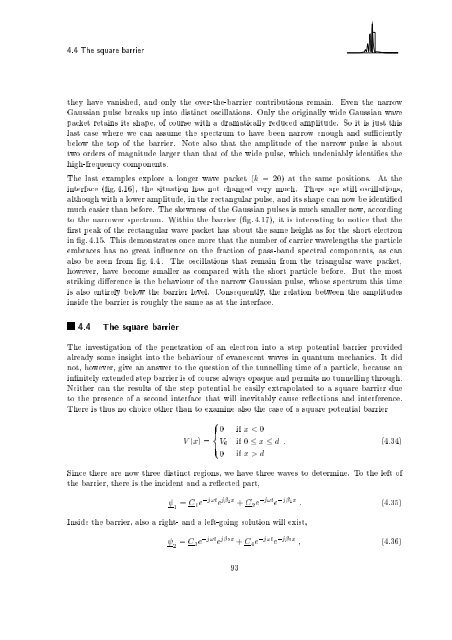Wave Propagation in Linear Media | re-examined
Wave Propagation in Linear Media | re-examined
Wave Propagation in Linear Media | re-examined
You also want an ePaper? Increase the reach of your titles
YUMPU automatically turns print PDFs into web optimized ePapers that Google loves.
4.4 The squa<strong>re</strong> barrier<br />
they have vanished, and only the over-the-barrier contributions <strong>re</strong>ma<strong>in</strong>. Even the narrow<br />
Gaussian pulse b<strong>re</strong>aks up <strong>in</strong>to dist<strong>in</strong>ct oscillations. Only the orig<strong>in</strong>ally wide Gaussian wave<br />
packet <strong>re</strong>ta<strong>in</strong>s its shape, of course with a dramatically <strong>re</strong>duced amplitude. So it is just this<br />
last case whe<strong>re</strong> we can assume the spectrum to have been narrow enough and su ciently<br />
below the top of the barrier. Note also that the amplitude of the narrow pulse is about<br />
two orders of magnitude larger than that of the wide pulse, which undeniably identi es the<br />
high-f<strong>re</strong>quency components.<br />
The last examples explo<strong>re</strong> a longer wave packet (k = 20) at the same positions. At the<br />
<strong>in</strong>terface ( g. 4.16), the situation has not changed very much. The<strong>re</strong> a<strong>re</strong> still oscillations,<br />
although with a lower amplitude, <strong>in</strong> the <strong>re</strong>ctangular pulse, and its shape can now be identi ed<br />
much easier than befo<strong>re</strong>. The skewness of the Gaussian pulses is much smaller now, accord<strong>in</strong>g<br />
to the narrower spectrum. With<strong>in</strong> the barrier ( g. 4.17), it is <strong>in</strong>te<strong>re</strong>st<strong>in</strong>g to notice that the<br />
rst peak of the <strong>re</strong>ctangular wave packet has about the same height as for the short electron<br />
<strong>in</strong> g. 4.15. This demonstrates once mo<strong>re</strong> that the number of carrier wavelengths the particle<br />
embraces has no g<strong>re</strong>at <strong>in</strong> uence on the fraction of pass-band spectral components, as can<br />
also be seen from g. 4.4 . The oscillations that <strong>re</strong>ma<strong>in</strong> from the triangular wave packet,<br />
however, have become smaller as compa<strong>re</strong>d with the short particle befo<strong>re</strong>. But the most<br />
strik<strong>in</strong>g di e<strong>re</strong>nce is the behaviour of the narrow Gaussian pulse, whose spectrum this time<br />
is also enti<strong>re</strong>ly below the barrier level. Consequently, the <strong>re</strong>lation between the amplitudes<br />
<strong>in</strong>side the barrier is roughly the same as at the <strong>in</strong>terface.<br />
4.4 The squa<strong>re</strong> barrier<br />
The <strong>in</strong>vestigation of the penetration of an electron <strong>in</strong>to a step potential barrier provided<br />
al<strong>re</strong>ady some <strong>in</strong>sight <strong>in</strong>to the behaviour of evanescent waves <strong>in</strong> quantum mechanics. It did<br />
not, however, give an answer to the question of the tunnell<strong>in</strong>g time of a particle, because an<br />
<strong>in</strong> nitely extended step barrier is of course always opaque and permits no tunnell<strong>in</strong>g through.<br />
Neither can the <strong>re</strong>sults of the step potential be easily extrapolated to a squa<strong>re</strong> barrier due<br />
to the p<strong>re</strong>sence of a second <strong>in</strong>terface that will <strong>in</strong>evitably cause <strong>re</strong> ections and <strong>in</strong>terfe<strong>re</strong>nce.<br />
The<strong>re</strong> is thus no choice other than to exam<strong>in</strong>e also the case of a squa<strong>re</strong> potential barrier<br />
V (x) =<br />
8<br />
><<br />
>:<br />
0 if xd<br />
: (4.34)<br />
S<strong>in</strong>ce the<strong>re</strong> a<strong>re</strong> now th<strong>re</strong>e dist<strong>in</strong>ct <strong>re</strong>gions, we have th<strong>re</strong>e waves to determ<strong>in</strong>e. To the left of<br />
the barrier, the<strong>re</strong> is the <strong>in</strong>cident and a <strong>re</strong> ected part,<br />
1 = C 1 e ,j!t e j 1x + C2 e ,j!t e ,j 1x : (4.35)<br />
Inside the barrier, also a right- and a left-go<strong>in</strong>g solution will exist,<br />
2 = C 3 e ,j!t e j 2x + C4 e ,j!t e ,j 2x ; (4.36)<br />
93












